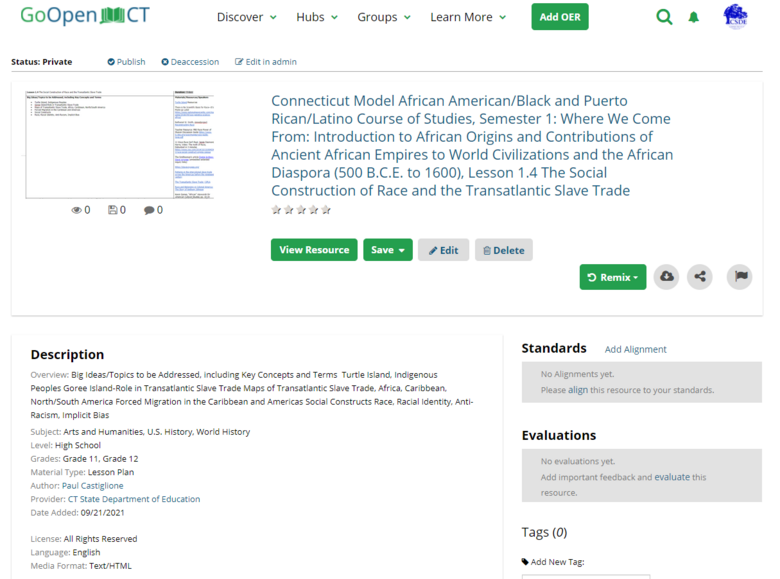Lesson 1.4: The Social Construction of Race and the Transatlantic Slave Trade

Overview
Big Ideas/Topics to be Addressed, including Key Concepts and Terms
Turtle Island, Indigenous Peoples
Goree Island-Role in Transatlantic Slave Trade
Maps of Transatlantic Slave Trade, Africa, Caribbean, North/South America
Forced Migration in the Caribbean and Americas
Social Constructs
Race, Racial Identity, Anti-Racism, Implicit Bias
Materials/Resources/Speakers
Turtle Island Resources
There is No Scientific Basis for Race—It’s a Made-up Label
https://www.nationalgeographic.com/magazine/2018/04/race-genetics-science-africa/
Nathaniel W. Smith, zinnedproject Reconstructing Race
Teacher Resource: PBS Race Power of Illusion Discussion Guide https://www-tc.pbs.org/race/images/race-guide-lores.pdf
11 Ways Race Isn’t Real, Jenée Desmond-Harris, Video: The myth of Race, Debunked in 3 minutes https://www.vox.com/2014/10/10/6943461/race-social-construct-origins-census
The Smithsonian’s article Digital Archive of Slave Voyages (embedded extended inquiry links)
Patterns in the intercolonial slave trade across the Americas before the nineteenth century
The Transatlantic Slave Trade | DPLA
Race and Belonging in Colonial America: The Story of Anthony Johnson
Kevin Gaines, “African” Keywords for
Recommended Learning Activities, including UDL Principles/Scaffolded Supports and Asynchronous and Synchronous Learning Opportunities
Recommended Learning Activities, including UDL Principles/Scaffolded Supports and Asynchronous and Synchronous Learning Opportunities
Day 1
Initiation: Students will review class norms and expectations for participation to ensure that perspectives are thoughtful, respectful, and in the spirit of learning as they strive to better understand and engage in difficult conversations about race. Class will be asked to Turn and Talk about why learning about race and racism is important for future classes about slavery.
Prompt for Turn and Talk: Where did the concept of race come from?
Fist to 5 - What is your comfort level in talking about race? (1 very uncomfortable to 5 very comfortable). Have students note where they are individually and collectively, and identify what “norms” they need for themselves and as a class.
Activity: Students will discuss the social construct of race and why understanding race is important for building our understanding of the history of slavery in America and globally.
Explore/Read/Discuss National Geographic Article: There's No Scientific Basis for Race—It's a Made-Up Label, share out in groups key understandings.
Closing/Evidence of Learning: Quick Write/Drawing - How does race impact your life? Early American culture?
Day 2
Initiation: Ask students to predict their genetic makeup if they were able to conduct a DNA test. Noting, some family members may have already done this and students may have this information verified already.
Activity: Explore/View/Discuss PBS Documentary Race – the Power of Illusion: Episode 1 The Difference Between Us (must be purchased). Teachers should be flexible and stop for reflection and discussion throughout the video.
Closing: Anthropologist Alan Goodman says that “to understand why the idea of race is a biological myth requires a major paradigm shift.” Do you agree? Did the film present anything that shifted your thinking in a major way? If so, what? Is it difficult to make this shift? Why? (Ask students to document in a journal.)
Day 3
Initiation: Using the map of Turtle Island, ask students how it got its name. Ask if they know how Turtle Island is represented in history, and what connections do they have with the construction of race and to the typical histories that are taught in the United States?
Activity: Using Tribal Nations Maps on computers in small groups, students will formulate questions they have about origins of the Americas from the perspective of Indigenous/Native Americans. Then they will listen to the podcast The Map Of Native American Tribes You've Never Seen Before to answer questions raised.
Closing: Full group discussion of what was learned- questions raised regarding Turtle Island and Indigenous/Native Americans.
Day 4
Initiation: Review of norms and safe space for sensitive discussions. Introduce key vocabulary: Forced Migration, Spanish Florida, emancipation, monolithic, atrocity, propaganda.
Activity: Discuss Forced Migration Map found in Caribbean Excavation Article. Provide students a note-taking graphic organizer and in small groups read and discuss Caribbean excavation offers intimate look at the lives of enslaved Africans.
Activity: Explore/Read/Discuss The Smithsonian’s article Digital Archive of Slave Voyages (embedded extended inquiry links in materials). Students will need Cornell Note-taking organizer (scaffold as needed) and computer. In small groups, engage students in unpacking what they know and have discovered about survival and resistance of African in this article.
Closing/Evidence of Learning: Students individually write a short response to answer questions pertaining to the impact of Africans on the Caribbean islands.
Day 5
Performance Task Presentations: This unit concludes with an End-of Unit Performance Task in which students collectively draw from their research to create and present a representation addressing the compelling question of the impact the people of Ancient Africa have on the development of humanity and civilization. Remind students of Compelling Questions they are striving to answer: What impact did the people of Ancient Africa have on humanity and civilization? How was race socially constructed over time?
Home Links/Reflections to Affirm Identity
Discuss with youth in your family how you honor your ancestors’ wisdom and achievement.
Options for Content Continuity Across History Courses and Interdisciplinary Integration
Engineering - Explore African Archeology
Art - Explore African Art and Artifacts, Symbols and their meaning
Graphic Arts and Design - Incorporate African textures, patterns in clothing, web design
Geography - Analyze maps, artifact of Transatlantic Slave Route
Extensions/Experiential Opportunities
Tour a local/national museum on Ancient Africa